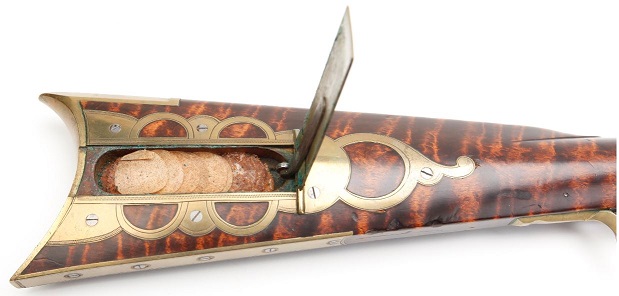In response to one of the patch box photos I posted on social media, a friend's adult daughter asked, 'What's the hinged part? It's really pretty." She did not know what the patch box was named, or what it was used for. That is when I realized that some aspects of my photos of antique Somerset and Bedford County, Pennsylvania long rifles might be interesting to people who are not died in the wool rifle cranks, and who may know little or nothing about antique firearms. This page was written for them, and answers the question "What's the hinged part?"
Long rifles load from the muzzle, and the projectile is a round ball that is wrapped in a greased cloth patch. The cloth patch engages the helical rifling grooves in the bore of the barrel and helps the rifling grooves spin the ball rapidly for stability and accuracy when the gun is fired. The muzzleloader patch box comprises a recess in the stock to store patches, and a mating lid that is usually spring loaded. The mechanism that opens the lid is called the release. Several different types of releases exist, and some are well-hidden for aesthetic advantage.

Photos of a patch box on a Pennsylvania long rifle
The first photo below shows a closed patch box on a Bedford County long rifle, and the second photo shows same patch box with the hinged lid open and the cloth patches visible. The example patch box was made by a member of the Border family of Bedford County, Pennsylvania. It has five piercings and the Q-shaped finial that was widely used on Bedford County rifles.
Both photos below are copyrighted by the National Rifle Association (NRA) and are included on this website courtesy of Erin Sabatini of the NRA Museums, nramuseum.org with the express permission of the NRA Museum.


L. Dietle

See the firearm photos portion of the gunsmithing project for other muzzleloader patch box examples
Return to the home page




